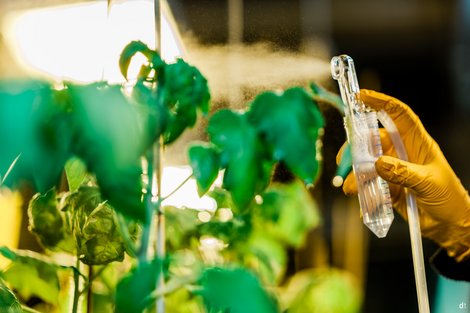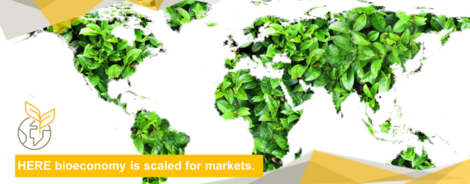Rhubarb Root Extract: Innovative Crop Protection Product Prevents Fungal Disease

Alternative crop protection agents are being developed at the Anhalt University of Applied Sciences
Spring barley, winter wheat, rye, tomatoes and vines are all prone to fungal diseases. Researchers from the Anhalt University of Applied Sciences in Bernburg have successfully combated harmful fungi and helped to make crops more resistant to fungal infections using an extract of rhubarb root. The formulations have been thoroughly tested and patented and are now ready for the approval process. With the help of a manufacturer, this innovative biological crop protection product from Saxony-Anhalt could soon be in use in the agricultural industry all over the world.
Versatile rhubarb root
Most people associate rhubarb with pies and cakes, but research into the varied uses of rhubarb root has been going on at the Anhalt University of Applied Sciences since the 1990s. For example, an extract of the root can be used as a sustainable leather tanning agent. Isolating, identifying and characterizing the functional properties of plant substances and producing plant extracts with defined effects are the core competencies of the working group at the Institute of Bioanalytical Sciences (IBAS). The deputy head of the group, Dr. Kathrin Kabrodt, demonstrated the antioxidative, immunomodulatory and antiviral properties of rhubarb root as early as 2007. In addition, Professor Ingo Schellenberg, the head of the group, succeeded in recruiting the phytopathologist Dr. Helmut Baltruschat to the team in 2011. His expertise made it possible to intensify the research into the antifungal properties of the root.
During her doctorate, Marit Gillmeister investigated the effect of the mixture of substances. The combination of polyphenolic flavonoids and stilbenes, such as epicatechin gallate and resveratrol, makes the root extract a biological magic weapon against fungi. The effect has been demonstrated in a number of field trials in collaboration with LGA Landwirtschaftsgesellschaft Arendsee GmbH, the Rollsdorfer Mühle vineyard in the Mansfelder Land region, the local horticultural center and Geisenheim University. “Field trials are, of course, always dependent on the weather,” explains Gillmeister. “This is why we are pleased that we were able to carry out tests in areas with different climates and produce successful results.”
Rhubarb fungicide from Saxony-Anhalt seeks a manufacturer
Alternative crop protection agents make an important contribution to the bioeconomy and to the development of sustainable ways of doing business. In addition to its antifungal effect, the rhubarb fungicide strengthens the plants’ immune system and makes them more resistant. It has been possible to demonstrate a synergistic effect when the rhubarb product is used in combination with the conventional fungicide Corbel. The product can therefore also be used to reinforce traditional crop protection agents and reduce the quantities that need to be applied.
Using a special extraction process in the laboratory and in small-scale production, the Anhalt University of Applied Sciences has manufactured the rhubarb fungicide at a competitive price. Enough extract can be produced from a rhubarb crop covering an area of 1.2 square meters to treat one hectare of cereals twice. This shows that the product will be cost-effective to manufacture on an industrial scale. The rhubarb plants themselves can be used to produce concentrated fruit acid, among other things. Roots are ready for harvesting to create the extract when the plant is around three years old. The time of year when the root is harvested has an influence on the concentration of the substances. The resveratrol content, for example, is highest in the fall. “The mixture is the key factor,” says Gillmeister. “The harvesting time is not crucial to the success of the process.” The extract has a shelf life of at least five years if stored in a cool location in airtight containers. “Our product is ready for approval,” explains Gillmeister. She would like to find a manufacturer that will launch this innovation onto the market.
New research into biostimulants and drought stress
The team of around 15 researchers in the working group is looking closely at the challenges currently faced by the agricultural industry. For example, in other doctoral theses researchers are studying the unknown substances in the roots of members of the buckwheat family (in this case sorrel) or in the fungal symbionts of plants growing in extreme conditions, such as on the waste tips from heavy metal mines in the Harz region. In another research project funded by the German Federal Ministry of Food and Agriculture (BMEL) via the Agency for Renewable Resources (FNR), drones are being used to investigate whether fungal isolates can protect crops from drought stress.
“Our native plants offer huge potential,” comments Gillmeister. “In our research work, we are focusing on developing practical, cost-effective manufacturing processes.” She is certain that this is the only way of transferring the results of research into the economy.
Author: Miriam Fuchs/IMG Saxony-Anhalt

Sustainable economic growth requires the responsible use of resources. This is a reality in Saxony-Anhalt: more than half of gross electricity production comes from renewable sources of energy.
> Learn more about bioeconomy in Saxony-Anhalt and the strength of Saxony-Anhalt as a location for bioeconomy.
